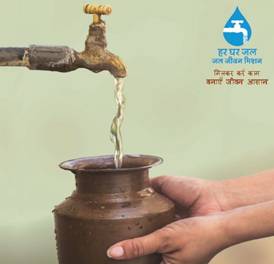Ministry of Jal Shakti
Jal Shakti Ministry reviews implementation of Jal Jeevan Mission in West Bengal; State shows dismal performance and provides just 2.20 lakh tap water connections against target of 55.58 lakh so far in 2020-21
Jal Shakti Ministry reiterates commitment to provide full assistance to West Bengal and urges State to speed-up implementation by utilizing available funds
प्रविष्टि तिथि:
30 OCT 2020 2:42PM by PIB Delhi

A mid-term review meeting on planning and implementation of Jal Jeevan Mission (JJM) in West Bengal was held, wherein the State officials presented the progress of the programme in the State before the National Jal Jeevan Mission team. State Government of West Bengal has decided to achieve the goal of providing tap water connections to all 1.63 Crore rural households by 2024. West Bengal has 22 Districts, 341 Blocks, 41,357 Villages and 1.07 lakh Habitations. The State has provided 2.20 lakh tap water connections against the target of 55.58 lakh so far in 2020-21.
Under Jal Jeevan Mission, funds are released by Government of India to States/ UTs based on the output in terms of tap water connections provided and the utilization of available central and matching state share. In 2020-21, fund allocation to West Bengal is Rs 1,610.76 Crore. Additional funds can be provided based on progress of implementation in form of performance incentive under the mission. In addition, West Bengal would receive Rs 4,412 Crore as 15th Finance Commission Grants to PRIs, 50% of which will mandatorily be spent on water and sanitation. In the review meeting, the Ministry requested the State to speed up the implementation to achieve the target in a time-bound manner by utilizing the available funds to avail the allocated funds so as to avoid losing the central grants. Union Government is committed to provide full assistance to the State Government in their efforts to achieve this goal of universal coverage of water supply to every household.
It was urged that due emphasis on strengthening of existing drinking water sources for long-term sustainability of drinking water supply systems should be provided. The State to also well utilize their existing resources through convergence of various programmes like MGNREGS, JJM, SBM (G), 15th FC Grants to PRIs, District Mineral Development Fund, CAMPA, CSR Fund, Local Area Development Fund, etc. at village level and a Village Action Plan (VAP) for 5 years needs to be prepared by dovetailing all these resources. The State also needs launch an effective IEC campaign for community mobilisation. State was urged that village communities to be empowered for effective planning and implementation of the mission; thus, enabling these villages as ‘Har Ghar Jal Gaon’.
It was observed in the review meeting that in 22,319 out of 41,357 villages of the State have Public Water Supply (PWS), which has the potential to provide about 1 Crore tap water connections to remaining households through retrofitting. West Bengal is affected by water contamination, which poses a serious health risk to the inhabitants. The 10 districts of the State are also gripped by another serious health concern that is Japanese Encephalitis and Acute Encephalitis Syndrome (JE-AES), affecting 42.96 lakh households, out of which only 2.34 lakh households (5.4%) have been provided with tap connections. The State has 1,566 Arsenic and Fluoride affected habitations to be covered with piped water supply by December, 2020.
State was requested to ensure all the anganwadi centres, ashramshalas and schools are provided piped water supply as part of the special 100-day campaign launched on 2 October, 2020, so that potable water is available in these institutions for drinking, hand washing, for use in toilets and for cooking of mid-day meals. This campaign offers a golden opportunity to provide safe water in these public institutions, so that children have access to safe water, which will improve their health and well-being for holistic development.
*****
APS/MG/AS
(रिलीज़ आईडी: 1668813)
आगंतुक पटल : 1677